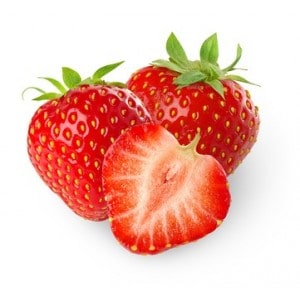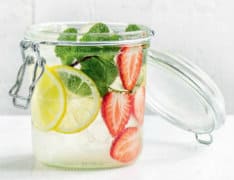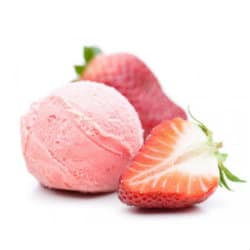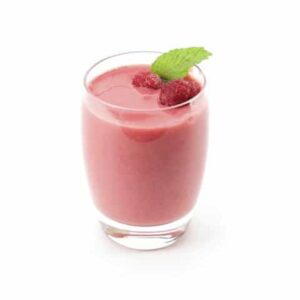A reliable source on many subjects.

A reliable source on many subjects.

![]()

Whether eaten as a dessert with sugar or whipped cream, in sweet preparations or in jam, the strawberry is one of the most widely used and appreciated fruits by children and adults alike.
Known to all and yet often underestimated for its slimming and antioxidant effects, strawberries can help me achieve my goal if I want to lose weight. So what is the composition of this tempting fruit, what are its various uses and how can I incorporate it into my daily diet?
 The strawberry is a fruit native to Europe and North America, consumed since Neolithic times and used by the Romans for its nutritional and cosmetic benefits.
The strawberry is a fruit native to Europe and North America, consumed since Neolithic times and used by the Romans for its nutritional and cosmetic benefits.
Belonging to the herbaceous Fragaria genus, it is distinguished by its bright red or whitish-yellow color, depending on the variety to which it belongs. In fact, there are many different varieties, which can be distinguished by their size, shape or flavor. They can also be distinguished by their taste, which can be sweet, like Darselect, or tangy, like Ciflorette, or woody, like Mara des bois.
Strawberries are available on the market all year round, but their peak season is between March and June. Some varieties, however, are available throughout the summer, only to be replaced by more resistant varieties in November.
Strawberries are rich in vitamin C, with an average level of 67.4 mg per 100 g, well above the average for other fruits (26 mg per 100 g). It covers 84.25% of the daily nutritional requirement for vitamin C, which boosts the body’s energy and reduces fatigue, as well as preventing cardiovascular disease.
Strawberries are also rich in vitamin B9, with an average content of 70.5 µg per 100 g. It covers 35.25% of vitamin B9 requirements, which serves to reduce the risks associated with hypertension and slow cognitive decline.
Strawberries are a considerable source of manganese, with an average level of 0.30 mg per 100 g, which helps reduce bad cholesterol and strengthen bones. Its potassium content dominates with an average of 171 mg per 100 g, which notably helps reduce water retention and participates in muscular integrity.
Polyunsaturated fatty acids make up 37.65% of lipids. These have a relatively low presence in the fruit, but still help to balance cholesterol levels and prevent cardiovascular disease.
Strawberries contain an average of 2g of fiber per 100g serving, which helps limit the risk of constipation and prevent intestinal complications.
Strawberries have an average carbohydrate content of 10.17g per 100g, which is quite low compared with other fresh fruits and therefore ideal for maintaining a healthy diet.
Strawberries have a total polyphenol content of around 65.34 mg per 100 g, which is higher than the average content found in fruit in general. They help to limit tumor formation in the body, thus limiting the development of cancer cells.

Strawberries are rich in vitamin C, which is very important for immunity, as well as being a powerful antioxidant ready to act in the bloodstream after just a few weeks’ consumption. It therefore helps combat fatigue and various bacterial and viral infections, and stimulates the immune system.
The antioxidants present in the fruit neutralize the potentially negative effects of free radicals, which are damaged cells that can reach neighboring healthy cells. This is particularly true of cancer cells in the colon, prostate and oral cavity.
Strawberries contain a powerful heart-health booster. Combined with a cholesterol-lowering diet, it reduces the oxidative damage and blood lipids that lead to chronic heart disease and diabetes.
Strawberries can help reduce joint inflammation, a possible source of arthritis and various heart problems. It can also help regulate blood pressure and even help lower hypertension.
Strawberries are a source of fiber, which stimulates intestinal transit and reduces bloating. They are also ideal for weight loss, as they are low in sugar and calories.
Strawberries also help keep skin healthier and younger-looking, and are widely used in cosmetics to reduce dark circles and puffiness under the eyes, exfoliate, tone and eliminate dead skin cells, and even considerably reduce pimples and traces of acne.
Vitamin B9, which is widely present in strawberries, is essential for the healthy development of the fetus, the proper functioning of the brain and nervous system during pregnancy, and even reduces the risk of congenital malformations. For the mother, vitamin C helps maintain good blood pressure.
And last but not least, it contains an interesting dose of endorphin (the happiness hormone), which helps to dispel gloomy thoughts and even helps with antidepressant treatment.
 During periods of weight loss, strawberries can be a great ally, especially for people who want to have a sweet snack to eat when they’re craving something.
During periods of weight loss, strawberries can be a great ally, especially for people who want to have a sweet snack to eat when they’re craving something.
Strawberries are rich in water, low in calories (around 28 to 33 calories for a 100-gram portion), low in sugar and carbohydrates, and virtually fat-free.
Strawberries also have antioxidant and diuretic properties. Strawberries also have antioxidant and diuretic properties, helping to eliminate toxins produced by the body, which is very important for a healthy body.
So it seems that strawberries are a must-have fruit, providing both a delicious treat full of health benefits and a boost to the body’s fat elimination process.
Strawberries are best eaten fresh after purchase. However, if they have to be refrigerated, they should not be kept for more than two or three days. They should be washed only when ready to serve, without soaking them in water, keeping their stalks on to avoid soaking. You should also avoid wrapping them to let them breathe.
To store in the freezer, it’s best to wash the fruit, remove the stalks and drain, then place them on a plate, spacing them out to freeze them for the first time. They can then be placed in bags for use when eating or preparing strawberry-based recipes.
When I want to lose weight, the best way for me to use strawberries is to leave them in their pure state. However, there are a number of easy, healthy recipes that will delight the taste buds while maintaining a balanced diet.
– In juice and milkshake
Strawberries are very appetizing and refreshing when used in juice, without sugar. It’s perfect for a diet and can be drunk every day, or even mixed with other fruits for an infinite variety of variations.
It can be mixed with low-fat yoghurt, fromage frais or milk for a milkshake with no unnecessary calories. It can also be served with nuts and low-fat cheeses.
– In summer, in salads and sorbets
It can be an important ingredient in fruit or even vegetable salads (served with strawberry vinegar, balsamic vinegar or white wine vinegar).
A very interesting alternative for long summer days is strawberry-based low-fat sorbets. Simply add a squeeze of lemon, blend and freeze.
– On the stove!
If you prefer hot dishes, strawberries can be pan-fried or grilled and served warm, or skewered with other chunks of fruit and even coated in a sauce made from lemon or orange juice.
If you like to take detox cures, there are strawberry-based diets that can be carried out over a period of no more than 3 to 5 days. The principle is to consume 1.5 kg of strawberries spread throughout the day. However, I advise you to consult your doctor or nutritionist to avoid any dietary deficiencies.
You should also be careful not to eat too many strawberries, which can cause hives and certain allergic reactions in predisposed individuals, or irritate the intestines in certain cases.